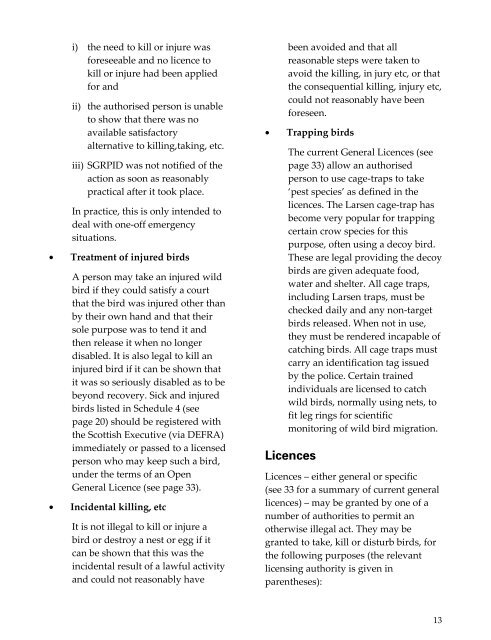WILD BIRDS AND THE LAW: SCOTLAND - RSPB
WILD BIRDS AND THE LAW: SCOTLAND - RSPB
WILD BIRDS AND THE LAW: SCOTLAND - RSPB
You also want an ePaper? Increase the reach of your titles
YUMPU automatically turns print PDFs into web optimized ePapers that Google loves.
i) the need to kill or injure was<br />
foreseeable and no licence to<br />
kill or injure had been applied<br />
for and<br />
ii) the authorised person is unable<br />
to show that there was no<br />
available satisfactory<br />
alternative to killing,taking, etc.<br />
iii) SGRPID was not notified of the<br />
action as soon as reasonably<br />
practical after it took place.<br />
In practice, this is only intended to<br />
deal with one-off emergency<br />
situations.<br />
• Treatment of injured birds<br />
A person may take an injured wild<br />
bird if they could satisfy a court<br />
that the bird was injured other than<br />
by their own hand and that their<br />
sole purpose was to tend it and<br />
then release it when no longer<br />
disabled. It is also legal to kill an<br />
injured bird if it can be shown that<br />
it was so seriously disabled as to be<br />
beyond recovery. Sick and injured<br />
birds listed in Schedule 4 (see<br />
page 20) should be registered with<br />
the Scottish Executive (via DEFRA)<br />
immediately or passed to a licensed<br />
person who may keep such a bird,<br />
under the terms of an Open<br />
General Licence (see page 33).<br />
• Incidental killing, etc<br />
It is not illegal to kill or injure a<br />
bird or destroy a nest or egg if it<br />
can be shown that this was the<br />
incidental result of a lawful activity<br />
and could not reasonably have<br />
been avoided and that all<br />
reasonable steps were taken to<br />
avoid the killing, in jury etc, or that<br />
the consequential killing, injury etc,<br />
could not reasonably have been<br />
foreseen.<br />
• Trapping birds<br />
The current General Licences (see<br />
page 33) allow an authorised<br />
person to use cage-traps to take<br />
‘pest species’ as defined in the<br />
licences. The Larsen cage-trap has<br />
become very popular for trapping<br />
certain crow species for this<br />
purpose, often using a decoy bird.<br />
These are legal providing the decoy<br />
birds are given adequate food,<br />
water and shelter. All cage traps,<br />
including Larsen traps, must be<br />
checked daily and any non-target<br />
birds released. When not in use,<br />
they must be rendered incapable of<br />
catching birds. All cage traps must<br />
carry an identification tag issued<br />
by the police. Certain trained<br />
individuals are licensed to catch<br />
wild birds, normally using nets, to<br />
fit leg rings for scientific<br />
monitoring of wild bird migration.<br />
Licences<br />
Licences – either general or specific<br />
(see 33 for a summary of current general<br />
licences) – may be granted by one of a<br />
number of authorities to permit an<br />
otherwise illegal act. They may be<br />
granted to take, kill or disturb birds, for<br />
the following purposes (the relevant<br />
licensing authority is given in<br />
parentheses):<br />
13

















